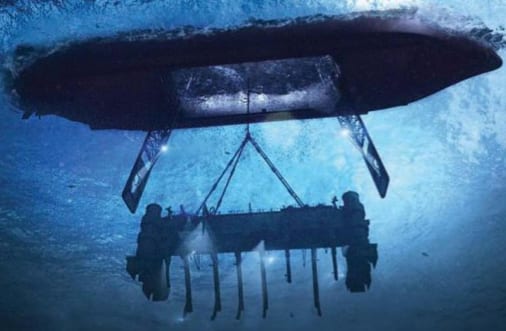PROJECT AZORIA, One of the Greatest intelligence Coups of the Cold War

Did you know that Project Azorian was one of the most complex, expensive, and secretive intelligence operations of the Cold War that cost about $800 million, or $4.7 billion today?
Project Azorian was a United States Central Intelligence Agency (CIA) project aimed to recover the sunken Soviet submarine K-129 from the Pacific Ocean floor in 1974 using the purpose-built ship Hughes Glomar Explorer after the K-129 sank in 1968 approximately 1,600 miles (2,600 km) northwest of Hawaii. Tagged as CIA's underwater robbery, Project Azorian serves as proof of the USA’s resourcefulness and resolve during the geopolitical conflicts of the time.
In the covert annals of Cold War espionage, few operations rival the audacity and technical ingenuity of Project Azorian. Under the guise of a deep-sea mining venture, the CIA orchestrated a complex salvage mission to retrieve the K-129 and its potentially invaluable cargo of nuclear missiles. At that time, retrieving anything from the staggering depths of 16,500 feet remained an unparalleled feat, especially considering the weight of the object, estimated at around 2,000 tons. But how did it all began?
On 24 February 1968, K-129, a Soviet Project 629A ballistic missile submarine attached to the 15th Submarine Squadron of the Soviet Pacific Fleet, departed from Rybachiy Naval Base in Kamchatka on what was a routine missile patrol. It was its third following the completion of a major modernization the previous year. During its intended cruise, the boat was expected to make standard radio contact with its commanders in Kamchatka, first when crossing the 180th meridian, and second when arriving on station. By the third week of March, with K-129 having missed its designated check-ins, and not responding to communication attempts, the submarine was declared missing.
In April 1968, Soviet Pacific Fleet surface and air assets were observed conducting a surge deployment to the North Pacific Ocean that involved some unusual search operations. The activity was evaluated by the United States Office of Naval Intelligence (ONI) as a possible reaction to the loss of a Soviet submarine. Soviet surface ship searches were centered on a location known to be associated with Soviet Golf II-class strategic ballistic missile (SSB) diesel submarine patrol routes. After weeks of searching, the Soviets were unable to locate the sunken boat, and Soviet Pacific Fleet operations gradually returned to normal.
The American Sophisticated Sound Surveillance System (SOSUS) hydrophone network in the northern Pacific was tasked with reviewing its recordings in the hope of detecting an implosion (or explosion) related to such a loss. The Navy analyzed acoustic data from four AFTAC sites and the Adak, Alaska SOSUS array, locating the wreck of the submarine to within 5 nautical miles (9 km). The site was hundreds of miles away from the Soviet Navy search area.
Naval Facility (NAVFAC) Point Sur, south of Monterey, California, was able to isolate a sonic signature on its low-frequency array recordings of an implosion event that had occurred on March 8, 1968. Using NavFac Point Sur's date and time of the event, NavFac Adak and the US West Coast NAVFAC were also able to isolate the acoustic event. With five SOSUS lines-of-bearing, Naval Intelligence was able to localize the site of the K-129 wreck to the vicinity of 40.1° N latitude and 179.9° E longitude (close to the International Date Line).
In July 1968, the United States Navy initiated "Operation Sand Dollar" with the deployment of USS Halibut from Pearl Harbor to the wreck site to find and photograph K-129. In 1968 Halibut, which had been configured to use deep submergence search equipment, was the only such specially-equipped submarine then in US inventory. It located the wreck after three weeks of visual search using robotic remote-controlled cameras. Halibut is reported to have spent the next several weeks taking over 20,000 closeup photos of every aspect of the K-129 wreck, a feat for which Halibut received a special classified Presidential Unit Citation signed by Lyndon B. Johnson in 1968.
_1710336473.jpg)
In 1970, based upon this photography, Defense Secretary Melvin Laird and Henry Kissinger, then National Security Advisor, proposed a clandestine plan to recover the wreckage so that the US could study Soviet nuclear missile technology, as well as possibly recover cryptographic materials. The proposal was accepted by President Richard Nixon and the CIA was tasked to attempt the recovery.
Hughes Glomar Explorer employed a large mechanical claw, which Lockheed officially titled the "Capture Vehicle" but affectionately called Clementine. The capture vehicle was designed to be lowered to the ocean floor, grasp the targeted submarine section, and then lift that section into the ship's hold. One requirement of this technology was to keep the floating base stable and in position over a fixed point 16,000 feet (4,900 m) below the ocean surface.
The capture vehicle was lowered and raised on a pipe string similar to those used on oil drilling rigs. Section by section, pairs of 30-foot (9.1 m) steel pipes were strung together to lower the claw through a hole in the middle of the ship. This configuration was designed by Western Gear Corp. of Everett, Washington. Upon a successful capture by the claw, the lift reversed the process – 60-foot (18 m) pairs drawn up and removed one at a time. The salvaged "Target Object" was thus to be drawn into a moon pool, the doors of which could then be closed to form a floor for the salvaged section. This allowed for the entire salvage process to take place underwater, away from the view of other ships, aircraft, or spy satellites.
Hughes Glomar Explorer arrived at the recovery site on July 4, 1974, after departing from Long Beach, California, on June 20, and traveling sailing 3,008 nautical miles (5,571 km). The ship conducted salvage operations for over a month. During this period, at least two Soviet Navy ships visited Hughes Glomar Explorer's work site, the oceangoing tugboat SB-10, and the Soviet missile range instrumentation ship Chazma. It was found out after 1991 that the Soviets were tipped off about the operation and were aware that the CIA was planning some kind of salvage operation, but the military command believed it impossible that they could perform such a task and disregarded further intelligence warnings. Later, Soviet Ambassador Anatoly Dobrynin started sending urgent messages back to the Soviet Navy warning that an operation was imminent. Soviet military engineering experts reevaluated their positions and claimed that it was indeed possible (though highly unlikely) to recover K-129, and ships in the area were ordered to report any unusual activity, although the lack of knowledge as to where K-129 was located impeded their ability to stop any salvage operation.
US Army Major General Roland Lajoie stated that, according to a briefing he received by the CIA during recovery operations, Clementine suffered a catastrophic failure, causing two-thirds of the already raised portion of K-129 to sink back to the ocean floor. Former Lockheed and Hughes Global Marine employees who worked on the operation have stated that several of the "claws" intended to grab the submarine fractured, possibly because they were manufactured from maraging steel, which is very strong, but not very ductile compared with other kinds of steel.
The recovered section included two nuclear torpedoes, and thus Project Azorian was not a complete failure. The bodies of six crewmen were also recovered, and were given a memorial service and with military honors, buried at sea in a metal casket because of radioactivity concerns. Other crew members have reported that code books and other materials of apparent interest to CIA employees aboard the vessel were recovered, and images of inventory printouts exhibited in the documentary suggest that various submarine components, such as hatch covers, instruments and sonar equipment were also recovered. White's documentary also states that the ship's bell from K-129 was recovered, and was subsequently returned to the Soviet Union as part of a diplomatic effort. The CIA considered the project one of the greatest intelligence coups of the Cold War.
The entire salvage operation was recorded by a CIA documentary film crew, but this film remains classified. A short portion of the film, showing the recovery and subsequent burial at sea of the six bodies recovered in the forward section of K-129, was given to the Russian government in 1992.
SOURCES: Wikipedia | Eurasiantimes | Image: Defense Media Network
#penglobalhistory



